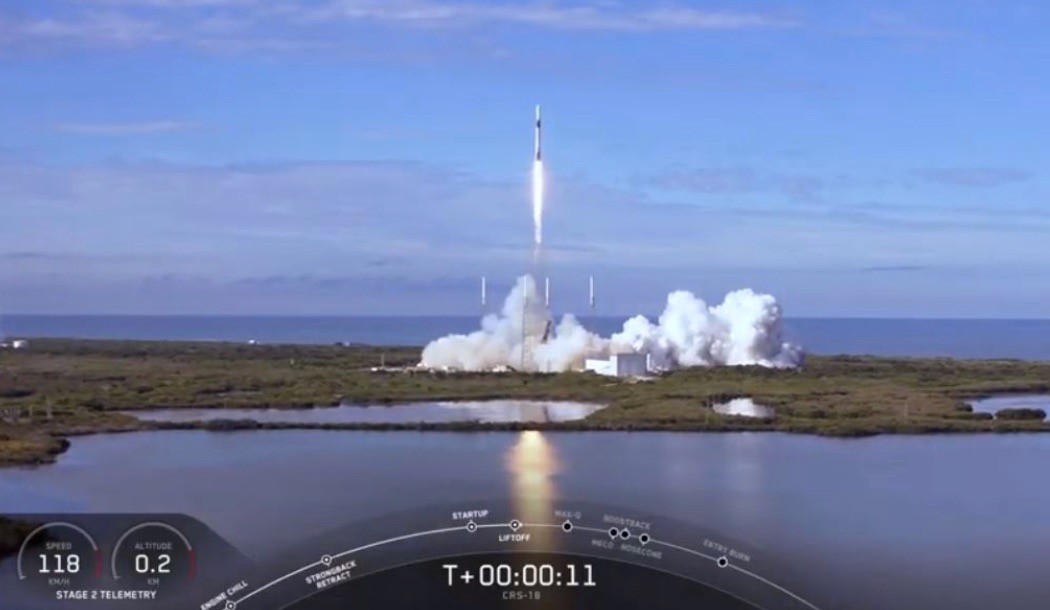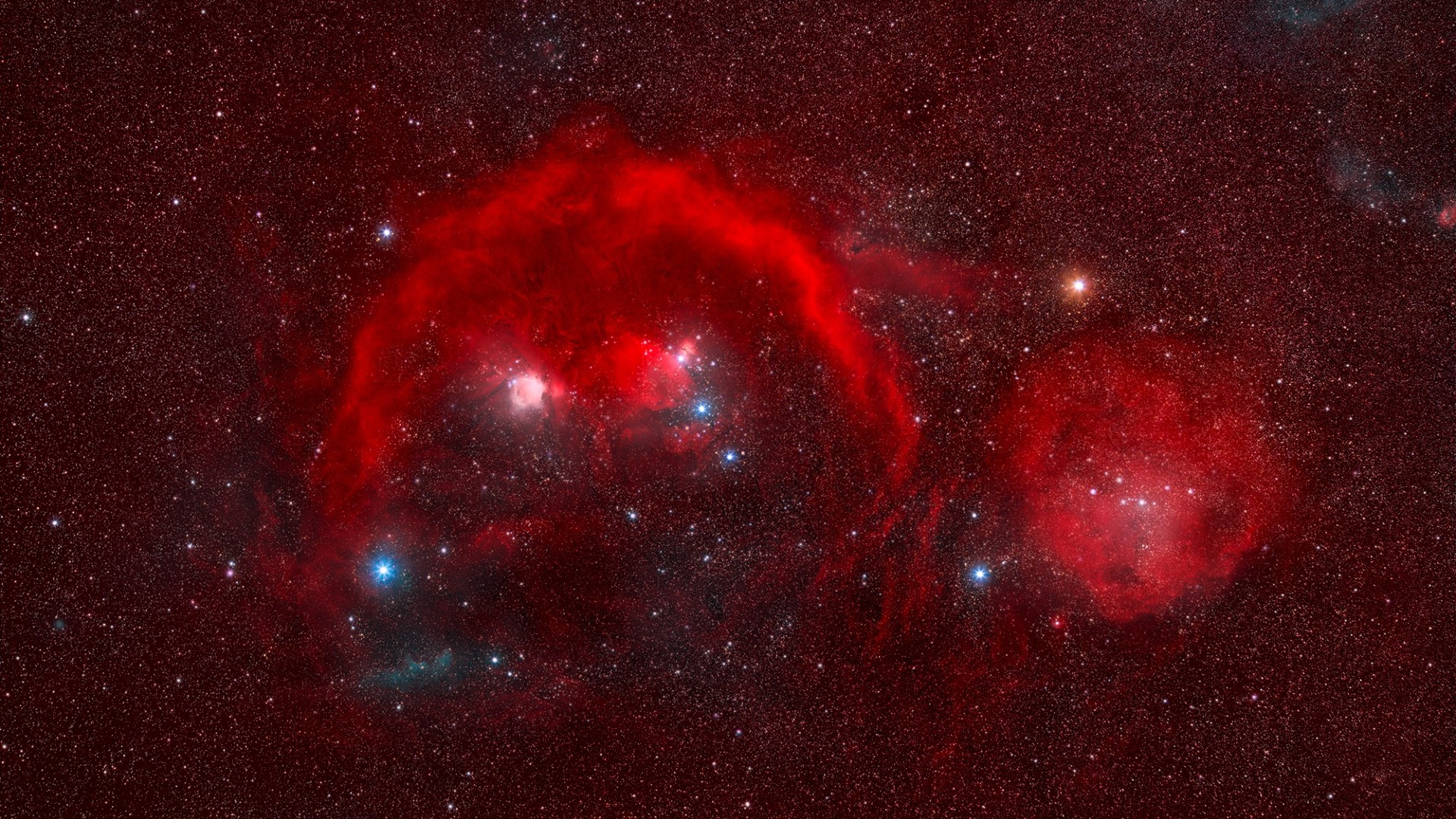SpaceX Launches Used Dragon Capsule on Historic 3rd Cargo Run to Space Station
Dragon's Falcon 9 rocket was preflown as well.
CAPE CANAVERAL, Fla. — SpaceX successfully launched its 18th commercial cargo mission to the International Space Station today (July 25), then stuck a rocket landing at the company's nearby landing site, LZ-1.
After a one-day delay caused by bad weather, SpaceX's two-stage Falcon 9 rocket lifted off at 6:01 p.m. EDT (2201 GMT) from Launch Complex 40 here at Cape Canaveral Air Force Station, carrying the company's robotic Dragon cargo capsule toward the orbiting lab.
Cheers erupted from crowds of anxious onlookers as the Falcon 9 roared to life. The rumble from the rocket's engines set off car alarms at the NASA press site during both launch and landing.
Related: How SpaceX's Dragon Space Capsule Works (Infographic)

This flight marks the 18th mission for SpaceX under its commercial cargo resupply services contract with NASA. Of the missions flown to date, this is the seventh overall to feature a preflown Dragon and marks the first time the same Dragon spacecraft has flown to the station three times — CRS-6 in April 2015, the CRS-13 mission in December 2017 and now CRS-18.
To mark this achievement, Dragon is sporting two ISS decals, along with another to commemorate the 50th anniversary of the Apollo 11 moon landing. (Apollo 11 ended 50 years ago yesterday, splashing down safely in the Pacific Ocean on July 24, 1969.)
"Historically today, 50 years ago, we were able to complete Kennedy's challenge to get men to the moon," Bill Specht, NASA's deputy manager for ISS Transport Integration, said during a prelaunch news conference yesterday.
Breaking space news, the latest updates on rocket launches, skywatching events and more!
He explained that NASA and SpaceX want to honor not only the Apollo 11 astronauts but also Chris Kraft, who passed away on Monday (July 22) at the age of 95. "He was the founder for mission control and laid the groundwork for how we operate in space today," Specht said of Kraft, who was NASA's first flight director.
Today marks the first time a Dragon has flown to the space station three times, but it won't be the last. Each of the next two cargo resupply missions — CRS-19 and CRS-20 — will also be the third flight for their respective Dragon spacecraft.
In the same prelaunch news conference yesterday, SpaceX officials explained that each Dragon cargo craft is certified to fly three times before retirement. The California-based company currently has a fleet of 13 Dragons and flies each one approximately once every 1.5 years.
SpaceX also says that turnaround time will be much faster once its updated cargo vehicle, known as Dragon 2 (as opposed to the current Dragon 1), enters service beginning with the CRS-21 mission in late 2020. That craft will land in the Atlantic Ocean (versus the Pacific like the current Dragon), and all vehicles will be refurbished in Florida, further reducing downtime.
Related: Cosmic Quiz: Do You Know the International Space Station?
Today's launch also starred one of SpaceX's flight-proven boosters. Designated with the internal company identifier B1056.2, the rocket already had one launch and landing under its belt; its first stage helped hoist a different Dragon cargo capsule, as part of the company's 17th resupply mission in May of this year.
The first stage featured in today's flight also looked a little different from previous versions. Just above the black interstage (the piece that connects the rocket's two stages) was a new gray stripe. SpaceX added the feature as a way to test thermal properties related to the rocket's second-stage propellant tank.
The Falcon 9 relies on two different types of propellant to make it to orbit: RP-1, a refined version of kerosene; and superchilled liquid oxygen, or LOX, as the oxidizer.
SpaceX superchills the Falcon's propellants, which shrinks the fuel volume so that more can be packed into the rocket's tanks. (More fuel means more lifting capability.)
But there's an issue: The propellants operate best at certain temperatures. So that means that on missions that feature long coast phases, like those targeting geostationary orbit, the second stage has to relight many hours after launch. During the down time, the onboard fuel can cool to below acceptable temperatures.
This means that SpaceX must re-chill the LOX while simultaneously raising the temperature of the RP-1. The addition of the gray stripe will allow the company to test thermal conditions in the fuel tank.
SpaceX chose the CRS-18 mission to test it out because the company has performed second-stage burn tests before on CRS missions and therefore has a good baseline comparison. Depending on how the testing goes, the gray stripe could be a permanent addition, company representatives said.
SpaceX also said that the Dragon spacecraft is sporting some new hardware — a few small heat-shield tiles. The tiles are installed on the cargo ship’s leading edge and could be used on the company’s future Mars-colonizing Starship spacecraft.
The company received the go-ahead from NASA to add the novel tiles, and company representatives said they pose no risk to the mission. Their purpose: to collect data.
During yesterday's prelaunch news conference, SpaceX also revealed why this mission's static-fire test was delayed. The preflight test — originally estimated to take place on July 16 — appeared to go off without a hitch, following a three-day schedule delay.
At the time, no reason was given for the delay, but yesterday morning SpaceX representatives said that there was a small LOX leak on the Falcon's first stage last week when technicians were preparing to static fire. The issue was corrected, and the test occurred on July 19.
This mission marks the 24th reflight of a Falcon 9 booster and the 44th landing to date. Several minutes after liftoff, the Falcon 9 booster did an aerial somersault and headed back to Earth. Following a series of three burns, the booster stuck its landing at LZ-1 as sonic booms cracked across the sky.
Dragon will spend the next two days catching up to the space station, hauling a smorgasbord of science experiments, crew supplies and hardware — more than 5,000 lbs. (2,268 kilograms) in total up to the orbital outpost. That includes 2,500 lbs. (1,135 kg) of scientific research, which will enable many experiments across the orbiting lab's Expeditions 59 and 60.
If all goes according to plan, the space station's robotic arm will capture Dragon Saturday morning (July 27), and the capsule will be installed soon after. Dragon will remain on station for roughly a month before it departs for a splashdown in the Pacific Ocean, returning a stash of valuable science to researchers here on Earth.
- SpaceX's Falcon 9: Rocket for the Dragon
- See the Evolution of SpaceX's Rockets in Pictures
- SpaceX's Amazing Dragon CRS-17 NASA Cargo Launch (and Landing!) in Photos
Follow Amy Thompson on Twitter @astrogingersnap. Follow us on Twitter @Spacedotcom or Facebook.
Join our Space Forums to keep talking space on the latest missions, night sky and more! And if you have a news tip, correction or comment, let us know at: community@space.com.

Amy Thompson is a Florida-based space and science journalist, who joined Space.com as a contributing writer in 2015. She's passionate about all things space and is a huge science and science-fiction geek. Star Wars is her favorite fandom, with that sassy little droid, R2D2 being her favorite. She studied science at the University of Florida, earning a degree in microbiology. Her work has also been published in Newsweek, VICE, Smithsonian, and many more. Now she chases rockets, writing about launches, commercial space, space station science, and everything in between.
